Mechanical Engineering: Dynamics Assignment - Vibration Analysis
VerifiedAdded on 2021/10/12
|10
|1151
|89
Homework Assignment
AI Summary
This document presents a detailed solution to a mechanical engineering dynamics assignment. The solution begins with deriving equations of motion for a two-pendulum system using moment equilibrium equations at points P and Q. It then calculates natural frequencies and modal shapes, assuming simple harmonic motion, and expresses the equations in matrix form. The analysis proceeds to determine the linear vibration response using superposition of natural modes, considering initial conditions. The document also solves a multi-mass system problem using Newton's second law and Lagrange's equation of motion, deriving equations for each mass and expressing them in matrix form. The assignment covers various aspects of dynamics, including vibration analysis, equations of motion, and system modeling.
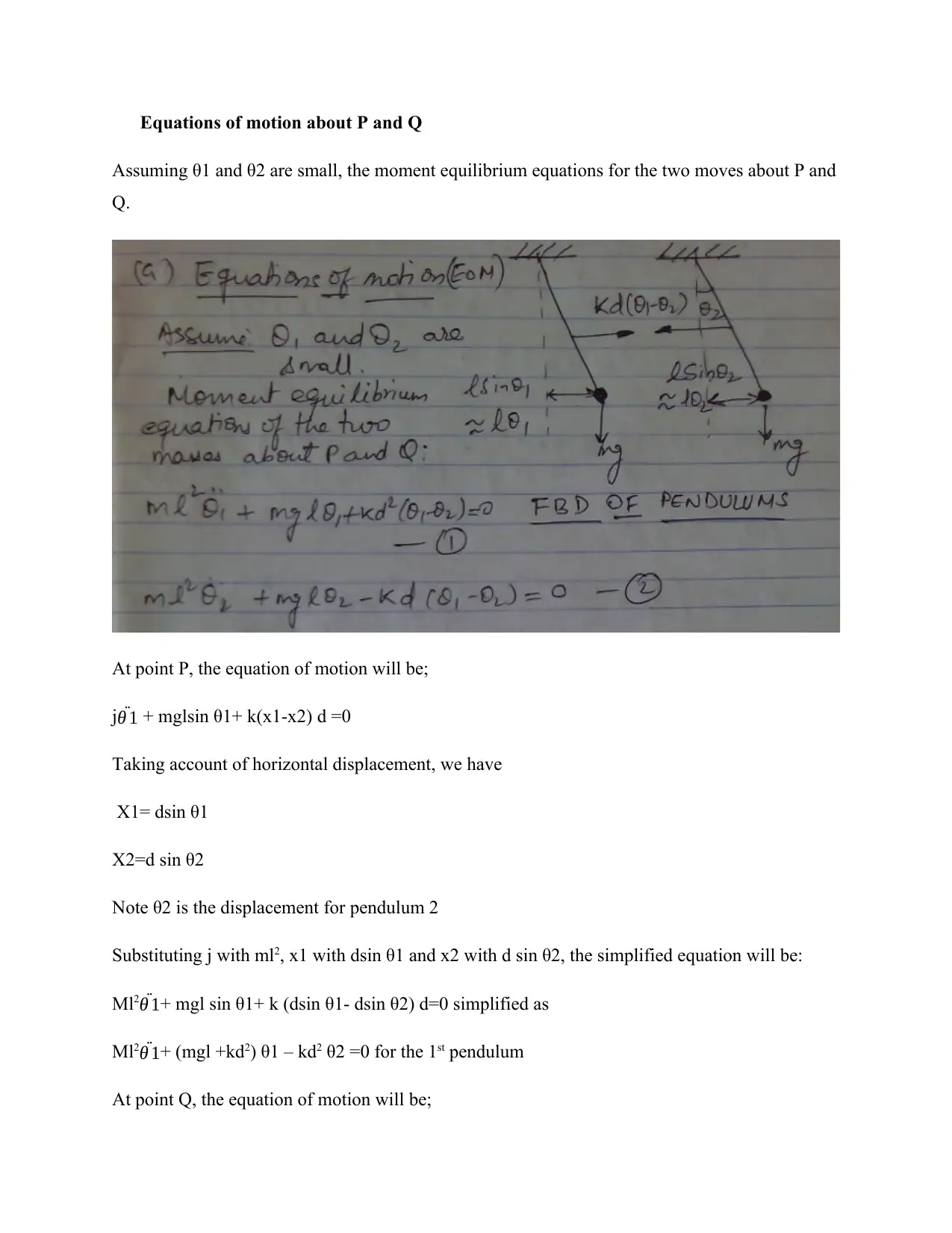
Equations of motion about P and Q
Assuming θ1 and θ2 are small, the moment equilibrium equations for the two moves about P and
Q.
At point P, the equation of motion will be;
j ¨θ 1 + mglsin θ1+ k(x1-x2) d =0
Taking account of horizontal displacement, we have
X1= dsin θ1
X2=d sin θ2
Note θ2 is the displacement for pendulum 2
Substituting j with ml2, x1 with dsin θ1 and x2 with d sin θ2, the simplified equation will be:
Ml2 ¨θ 1+ mgl sin θ1+ k (dsin θ1- dsin θ2) d=0 simplified as
Ml2 ¨θ 1+ (mgl +kd2) θ1 – kd2 θ2 =0 for the 1st pendulum
At point Q, the equation of motion will be;
Assuming θ1 and θ2 are small, the moment equilibrium equations for the two moves about P and
Q.
At point P, the equation of motion will be;
j ¨θ 1 + mglsin θ1+ k(x1-x2) d =0
Taking account of horizontal displacement, we have
X1= dsin θ1
X2=d sin θ2
Note θ2 is the displacement for pendulum 2
Substituting j with ml2, x1 with dsin θ1 and x2 with d sin θ2, the simplified equation will be:
Ml2 ¨θ 1+ mgl sin θ1+ k (dsin θ1- dsin θ2) d=0 simplified as
Ml2 ¨θ 1+ (mgl +kd2) θ1 – kd2 θ2 =0 for the 1st pendulum
At point Q, the equation of motion will be;
Paraphrase This Document
Need a fresh take? Get an instant paraphrase of this document with our AI Paraphraser
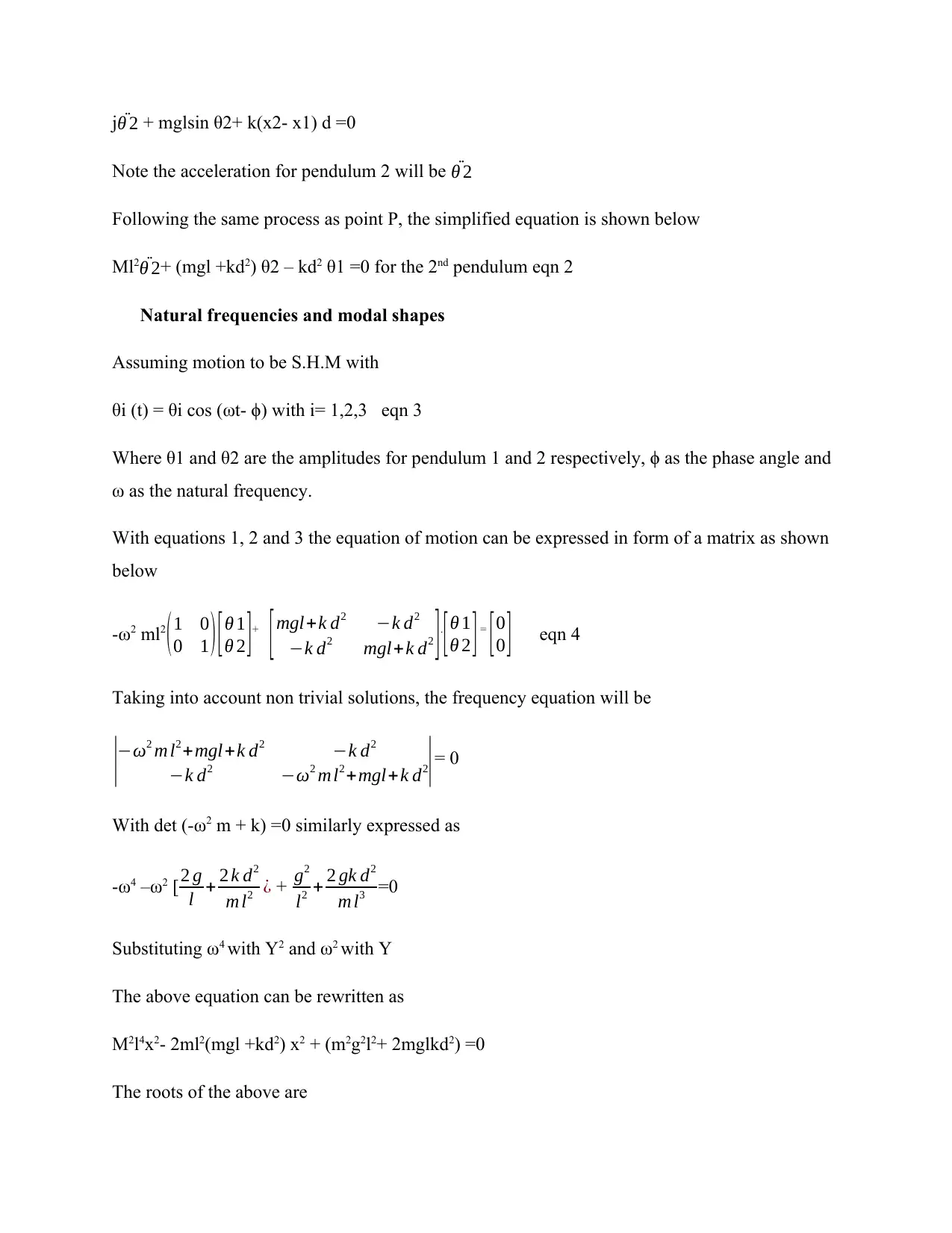
j ¨θ 2 + mglsin θ2+ k(x2- x1) d =0
Note the acceleration for pendulum 2 will be ¨θ 2
Following the same process as point P, the simplified equation is shown below
Ml2 ¨θ 2+ (mgl +kd2) θ2 – kd2 θ1 =0 for the 2nd pendulum eqn 2
Natural frequencies and modal shapes
Assuming motion to be S.H.M with
θi (t) = θi cos (ωt- ϕ) with i= 1,2,3 eqn 3
Where θ1 and θ2 are the amplitudes for pendulum 1 and 2 respectively, ϕ as the phase angle and
ω as the natural frequency.
With equations 1, 2 and 3 the equation of motion can be expressed in form of a matrix as shown
below
-ω2 ml2
( 1 0
0 1 ) [ θ 1
θ 2 ]+
[mgl+k d2 −k d2
−k d2 mgl+k d2 ].
[θ 1
θ 2 ] =
[0
0 ] eqn 4
Taking into account non trivial solutions, the frequency equation will be
|−ω2 m l2+mgl+k d2 −k d2
−k d2 −ω2 m l2+mgl+k d2|= 0
With det (-ω2 m + k) =0 similarly expressed as
-ω4 –ω2 [2 g
l + 2 k d2
m l2 ¿ + g2
l2 + 2 gk d2
m l3 =0
Substituting ω4 with Y2 and ω2 with Y
The above equation can be rewritten as
M2l4x2- 2ml2(mgl +kd2) x2 + (m2g2l2+ 2mglkd2) =0
The roots of the above are
Note the acceleration for pendulum 2 will be ¨θ 2
Following the same process as point P, the simplified equation is shown below
Ml2 ¨θ 2+ (mgl +kd2) θ2 – kd2 θ1 =0 for the 2nd pendulum eqn 2
Natural frequencies and modal shapes
Assuming motion to be S.H.M with
θi (t) = θi cos (ωt- ϕ) with i= 1,2,3 eqn 3
Where θ1 and θ2 are the amplitudes for pendulum 1 and 2 respectively, ϕ as the phase angle and
ω as the natural frequency.
With equations 1, 2 and 3 the equation of motion can be expressed in form of a matrix as shown
below
-ω2 ml2
( 1 0
0 1 ) [ θ 1
θ 2 ]+
[mgl+k d2 −k d2
−k d2 mgl+k d2 ].
[θ 1
θ 2 ] =
[0
0 ] eqn 4
Taking into account non trivial solutions, the frequency equation will be
|−ω2 m l2+mgl+k d2 −k d2
−k d2 −ω2 m l2+mgl+k d2|= 0
With det (-ω2 m + k) =0 similarly expressed as
-ω4 –ω2 [2 g
l + 2 k d2
m l2 ¿ + g2
l2 + 2 gk d2
m l3 =0
Substituting ω4 with Y2 and ω2 with Y
The above equation can be rewritten as
M2l4x2- 2ml2(mgl +kd2) x2 + (m2g2l2+ 2mglkd2) =0
The roots of the above are
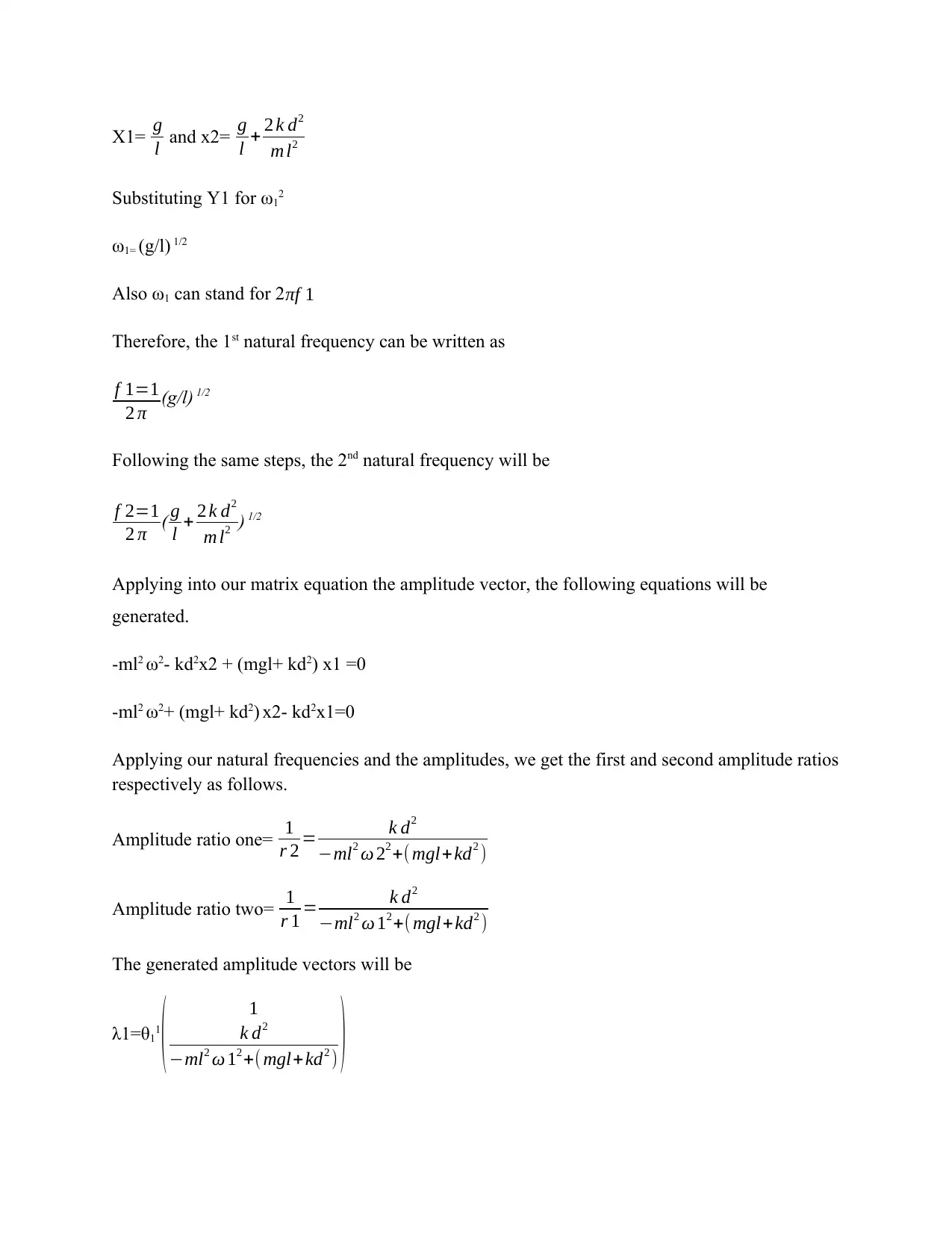
X1= g
l and x2= g
l + 2 k d2
m l2
Substituting Y1 for ω12
ω1= (g/l) 1/2
Also ω1 can stand for 2πf 1
Therefore, the 1st natural frequency can be written as
f 1=1
2 π (g/l) 1/2
Following the same steps, the 2nd natural frequency will be
f 2=1
2 π ( g
l + 2 k d2
m l2 ) 1/2
Applying into our matrix equation the amplitude vector, the following equations will be
generated.
-ml2 ω2- kd2x2 + (mgl+ kd2) x1 =0
-ml2 ω2+ (mgl+ kd2) x2- kd2x1=0
Applying our natural frequencies and the amplitudes, we get the first and second amplitude ratios
respectively as follows.
Amplitude ratio one= 1
r 2 = k d2
−ml2 ω 22+( mgl+kd2 )
Amplitude ratio two= 1
r 1 = k d2
−ml2 ω 12+( mgl+kd2 )
The generated amplitude vectors will be
λ1=θ11
( 1
k d2
−ml2 ω 12+( mgl+kd2 ) )
l and x2= g
l + 2 k d2
m l2
Substituting Y1 for ω12
ω1= (g/l) 1/2
Also ω1 can stand for 2πf 1
Therefore, the 1st natural frequency can be written as
f 1=1
2 π (g/l) 1/2
Following the same steps, the 2nd natural frequency will be
f 2=1
2 π ( g
l + 2 k d2
m l2 ) 1/2
Applying into our matrix equation the amplitude vector, the following equations will be
generated.
-ml2 ω2- kd2x2 + (mgl+ kd2) x1 =0
-ml2 ω2+ (mgl+ kd2) x2- kd2x1=0
Applying our natural frequencies and the amplitudes, we get the first and second amplitude ratios
respectively as follows.
Amplitude ratio one= 1
r 2 = k d2
−ml2 ω 22+( mgl+kd2 )
Amplitude ratio two= 1
r 1 = k d2
−ml2 ω 12+( mgl+kd2 )
The generated amplitude vectors will be
λ1=θ11
( 1
k d2
−ml2 ω 12+( mgl+kd2 ) )
⊘ This is a preview!⊘
Do you want full access?
Subscribe today to unlock all pages.

Trusted by 1+ million students worldwide
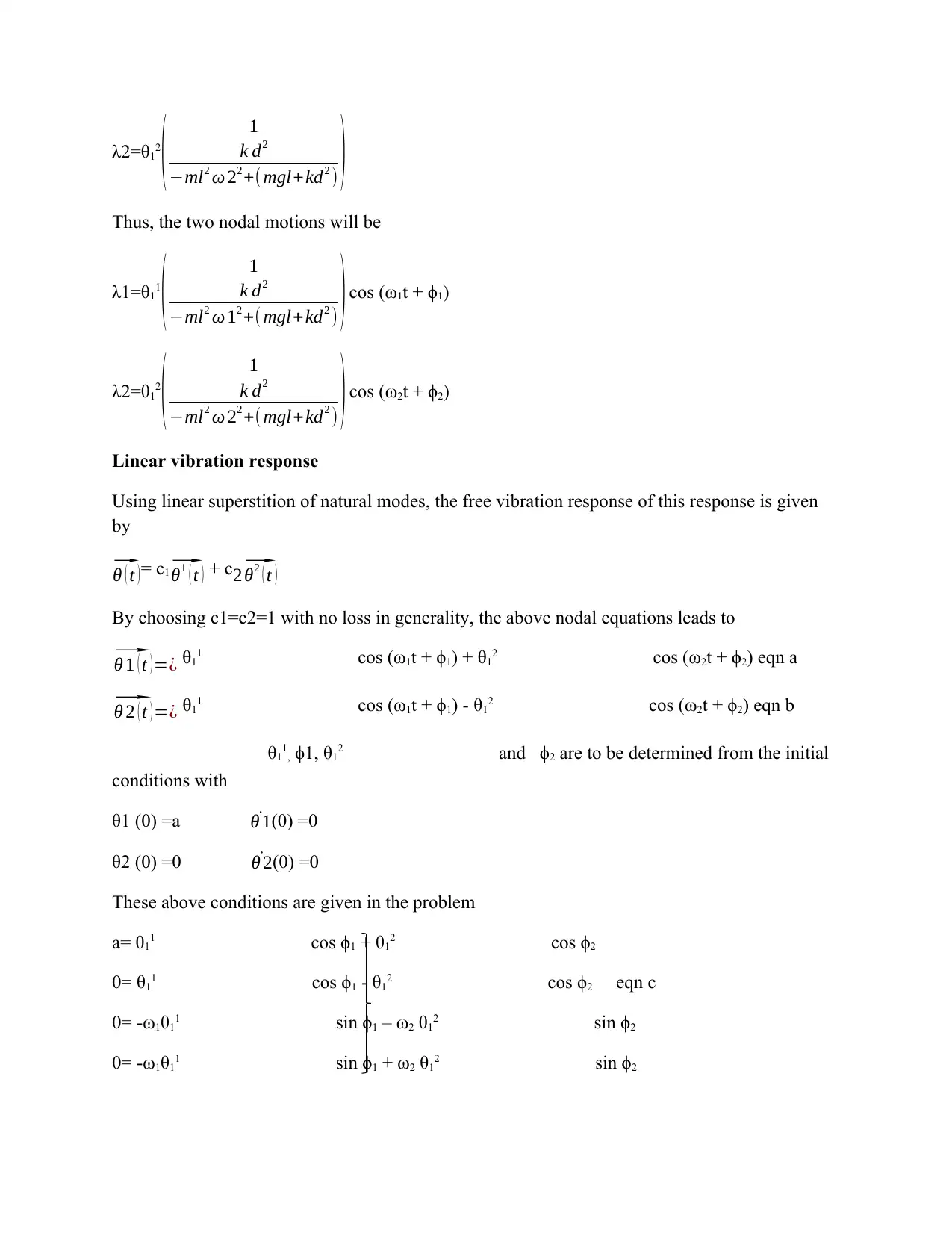
λ2=θ12
( 1
k d2
−ml2 ω 22+( mgl+kd2 ) )
Thus, the two nodal motions will be
λ1=θ11
( 1
k d2
−ml2 ω 12+( mgl+kd2 ) ) cos (ω1t + ϕ1)
λ2=θ12
( 1
k d2
−ml2 ω 22+( mgl+kd2 ) ) cos (ω2t + ϕ2)
Linear vibration response
Using linear superstition of natural modes, the free vibration response of this response is given
by ⃗
θ ( t )= c1⃗ θ1 ( t ) + c2⃗ θ2 ( t )
By choosing c1=c2=1 with no loss in generality, the above nodal equations leads to⃗
θ 1 ( t )=¿ θ11 cos (ω1t + ϕ1) + θ12 cos (ω2t + ϕ2) eqn a⃗
θ 2 ( t )=¿ θ11 cos (ω1t + ϕ1) - θ12 cos (ω2t + ϕ2) eqn b
θ11, ϕ1, θ12 and ϕ2 are to be determined from the initial
conditions with
θ1 (0) =a ˙θ 1(0) =0
θ2 (0) =0 ˙θ 2(0) =0
These above conditions are given in the problem
a= θ11 cos ϕ1 + θ12 cos ϕ2
0= θ11 cos ϕ1 - θ12 cos ϕ2 eqn c
0= -ω1θ11 sin ϕ1 – ω2 θ12 sin ϕ2
0= -ω1θ11 sin ϕ1 + ω2 θ12 sin ϕ2
( 1
k d2
−ml2 ω 22+( mgl+kd2 ) )
Thus, the two nodal motions will be
λ1=θ11
( 1
k d2
−ml2 ω 12+( mgl+kd2 ) ) cos (ω1t + ϕ1)
λ2=θ12
( 1
k d2
−ml2 ω 22+( mgl+kd2 ) ) cos (ω2t + ϕ2)
Linear vibration response
Using linear superstition of natural modes, the free vibration response of this response is given
by ⃗
θ ( t )= c1⃗ θ1 ( t ) + c2⃗ θ2 ( t )
By choosing c1=c2=1 with no loss in generality, the above nodal equations leads to⃗
θ 1 ( t )=¿ θ11 cos (ω1t + ϕ1) + θ12 cos (ω2t + ϕ2) eqn a⃗
θ 2 ( t )=¿ θ11 cos (ω1t + ϕ1) - θ12 cos (ω2t + ϕ2) eqn b
θ11, ϕ1, θ12 and ϕ2 are to be determined from the initial
conditions with
θ1 (0) =a ˙θ 1(0) =0
θ2 (0) =0 ˙θ 2(0) =0
These above conditions are given in the problem
a= θ11 cos ϕ1 + θ12 cos ϕ2
0= θ11 cos ϕ1 - θ12 cos ϕ2 eqn c
0= -ω1θ11 sin ϕ1 – ω2 θ12 sin ϕ2
0= -ω1θ11 sin ϕ1 + ω2 θ12 sin ϕ2
Paraphrase This Document
Need a fresh take? Get an instant paraphrase of this document with our AI Paraphraser
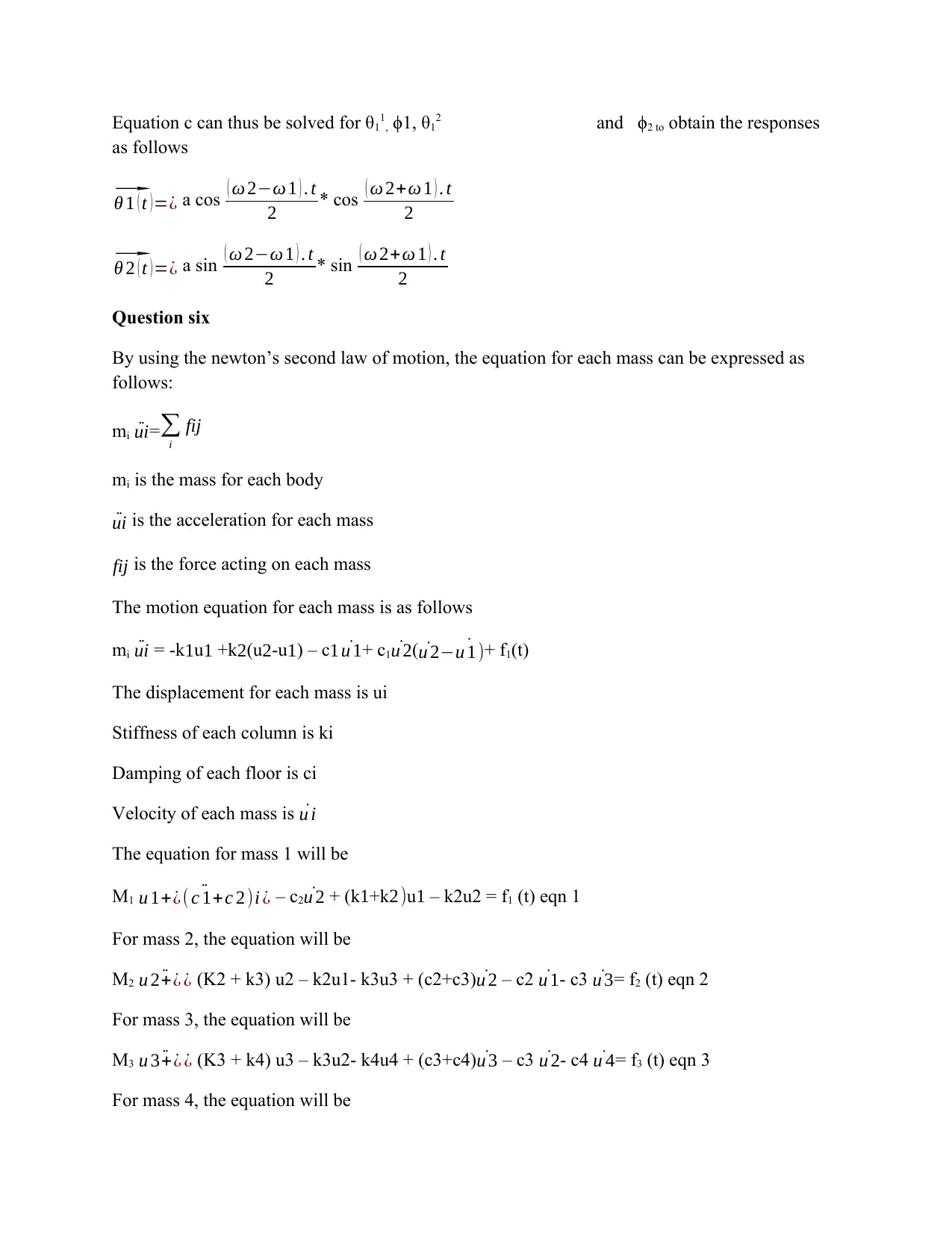
Equation c can thus be solved for θ11, ϕ1, θ12 and ϕ2 to obtain the responses
as follows⃗
θ 1 ( t )=¿ a cos ( ω 2−ω 1 ) . t
2 * cos ( ω 2+ω 1 ) . t
2 ⃗
θ 2 ( t )=¿ a sin ( ω 2−ω 1 ) . t
2 * sin ( ω 2+ω 1 ) . t
2
Question six
By using the newton’s second law of motion, the equation for each mass can be expressed as
follows:
mi ¨ui=∑
i
fij
mi is the mass for each body
¨ui is the acceleration for each mass
fij is the force acting on each mass
The motion equation for each mass is as follows
mi ¨ui = -k1u1 +k2(u2-u1) – c1 ˙u 1+ c1 ˙u 2( ˙u 2− ˙u 1)+ f1(t)
The displacement for each mass is ui
Stiffness of each column is ki
Damping of each floor is ci
Velocity of each mass is ˙u i
The equation for mass 1 will be
M1 ¨u 1+¿( c 1+c 2)i ¿ – c2 ˙u 2 + (k1+k2)u1 – k2u2 = f1 (t) eqn 1
For mass 2, the equation will be
M2 ¨u 2+¿ ¿ (K2 + k3) u2 – k2u1- k3u3 + (c2+c3) ˙u 2 – c2 ˙u 1- c3 ˙u 3= f2 (t) eqn 2
For mass 3, the equation will be
M3 ¨u 3+¿ ¿ (K3 + k4) u3 – k3u2- k4u4 + (c3+c4) ˙u 3 – c3 ˙u 2- c4 ˙u 4= f3 (t) eqn 3
For mass 4, the equation will be
as follows⃗
θ 1 ( t )=¿ a cos ( ω 2−ω 1 ) . t
2 * cos ( ω 2+ω 1 ) . t
2 ⃗
θ 2 ( t )=¿ a sin ( ω 2−ω 1 ) . t
2 * sin ( ω 2+ω 1 ) . t
2
Question six
By using the newton’s second law of motion, the equation for each mass can be expressed as
follows:
mi ¨ui=∑
i
fij
mi is the mass for each body
¨ui is the acceleration for each mass
fij is the force acting on each mass
The motion equation for each mass is as follows
mi ¨ui = -k1u1 +k2(u2-u1) – c1 ˙u 1+ c1 ˙u 2( ˙u 2− ˙u 1)+ f1(t)
The displacement for each mass is ui
Stiffness of each column is ki
Damping of each floor is ci
Velocity of each mass is ˙u i
The equation for mass 1 will be
M1 ¨u 1+¿( c 1+c 2)i ¿ – c2 ˙u 2 + (k1+k2)u1 – k2u2 = f1 (t) eqn 1
For mass 2, the equation will be
M2 ¨u 2+¿ ¿ (K2 + k3) u2 – k2u1- k3u3 + (c2+c3) ˙u 2 – c2 ˙u 1- c3 ˙u 3= f2 (t) eqn 2
For mass 3, the equation will be
M3 ¨u 3+¿ ¿ (K3 + k4) u3 – k3u2- k4u4 + (c3+c4) ˙u 3 – c3 ˙u 2- c4 ˙u 4= f3 (t) eqn 3
For mass 4, the equation will be
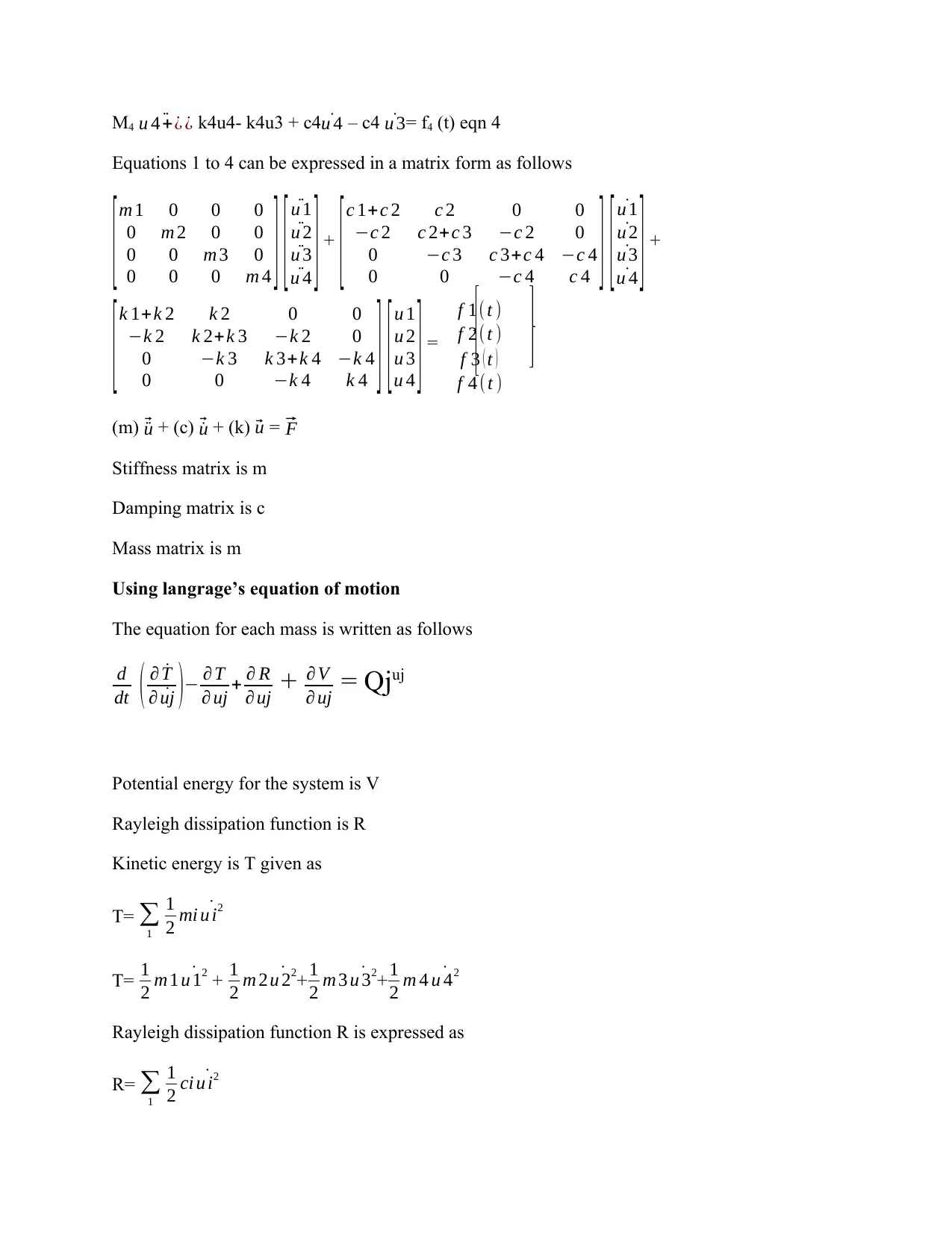
M4 ¨u 4+¿ ¿ k4u4- k4u3 + c4 ˙u 4 – c4 ˙u 3= f4 (t) eqn 4
Equations 1 to 4 can be expressed in a matrix form as follows
[m 1 0 0 0
0 m 2 0 0
0 0 m 3 0
0 0 0 m 4 ] [ ¨u 1
¨u 2
¨u 3
¨u 4 ] +
[ c 1+c 2 c 2 0 0
−c 2 c 2+c 3 −c 2 0
0 −c 3 c 3+c 4 −c 4
0 0 −c 4 c 4 ] [ ˙u 1
˙u 2
˙u 3
˙u 4 ] +
[k 1+k 2 k 2 0 0
−k 2 k 2+k 3 −k 2 0
0 −k 3 k 3+k 4 −k 4
0 0 −k 4 k 4 ] [ u 1
u 2
u 3
u 4 ] =
f 1( t )
f 2( t )
f 3 ( t )
f 4 ( t )
(m) ⃗ ¨u + (c) ⃗ ˙u + (k) ⃗ u = ⃗ F
Stiffness matrix is m
Damping matrix is c
Mass matrix is m
Using langrage’s equation of motion
The equation for each mass is written as follows
d
dt ( ∂ ˙T
∂ ˙uj )− ∂ T
∂ uj + ∂ R
∂ uj + ∂ V
∂ uj = Qjuj
Potential energy for the system is V
Rayleigh dissipation function is R
Kinetic energy is T given as
T= ∑
1
1
2 mi ˙u i2
T= 1
2 m 1 ˙u 12 + 1
2 m 2 ˙u 22+1
2 m 3 ˙u 32+1
2 m 4 ˙u 42
Rayleigh dissipation function R is expressed as
R= ∑
1
1
2 ci ˙u i2
Equations 1 to 4 can be expressed in a matrix form as follows
[m 1 0 0 0
0 m 2 0 0
0 0 m 3 0
0 0 0 m 4 ] [ ¨u 1
¨u 2
¨u 3
¨u 4 ] +
[ c 1+c 2 c 2 0 0
−c 2 c 2+c 3 −c 2 0
0 −c 3 c 3+c 4 −c 4
0 0 −c 4 c 4 ] [ ˙u 1
˙u 2
˙u 3
˙u 4 ] +
[k 1+k 2 k 2 0 0
−k 2 k 2+k 3 −k 2 0
0 −k 3 k 3+k 4 −k 4
0 0 −k 4 k 4 ] [ u 1
u 2
u 3
u 4 ] =
f 1( t )
f 2( t )
f 3 ( t )
f 4 ( t )
(m) ⃗ ¨u + (c) ⃗ ˙u + (k) ⃗ u = ⃗ F
Stiffness matrix is m
Damping matrix is c
Mass matrix is m
Using langrage’s equation of motion
The equation for each mass is written as follows
d
dt ( ∂ ˙T
∂ ˙uj )− ∂ T
∂ uj + ∂ R
∂ uj + ∂ V
∂ uj = Qjuj
Potential energy for the system is V
Rayleigh dissipation function is R
Kinetic energy is T given as
T= ∑
1
1
2 mi ˙u i2
T= 1
2 m 1 ˙u 12 + 1
2 m 2 ˙u 22+1
2 m 3 ˙u 32+1
2 m 4 ˙u 42
Rayleigh dissipation function R is expressed as
R= ∑
1
1
2 ci ˙u i2
⊘ This is a preview!⊘
Do you want full access?
Subscribe today to unlock all pages.

Trusted by 1+ million students worldwide
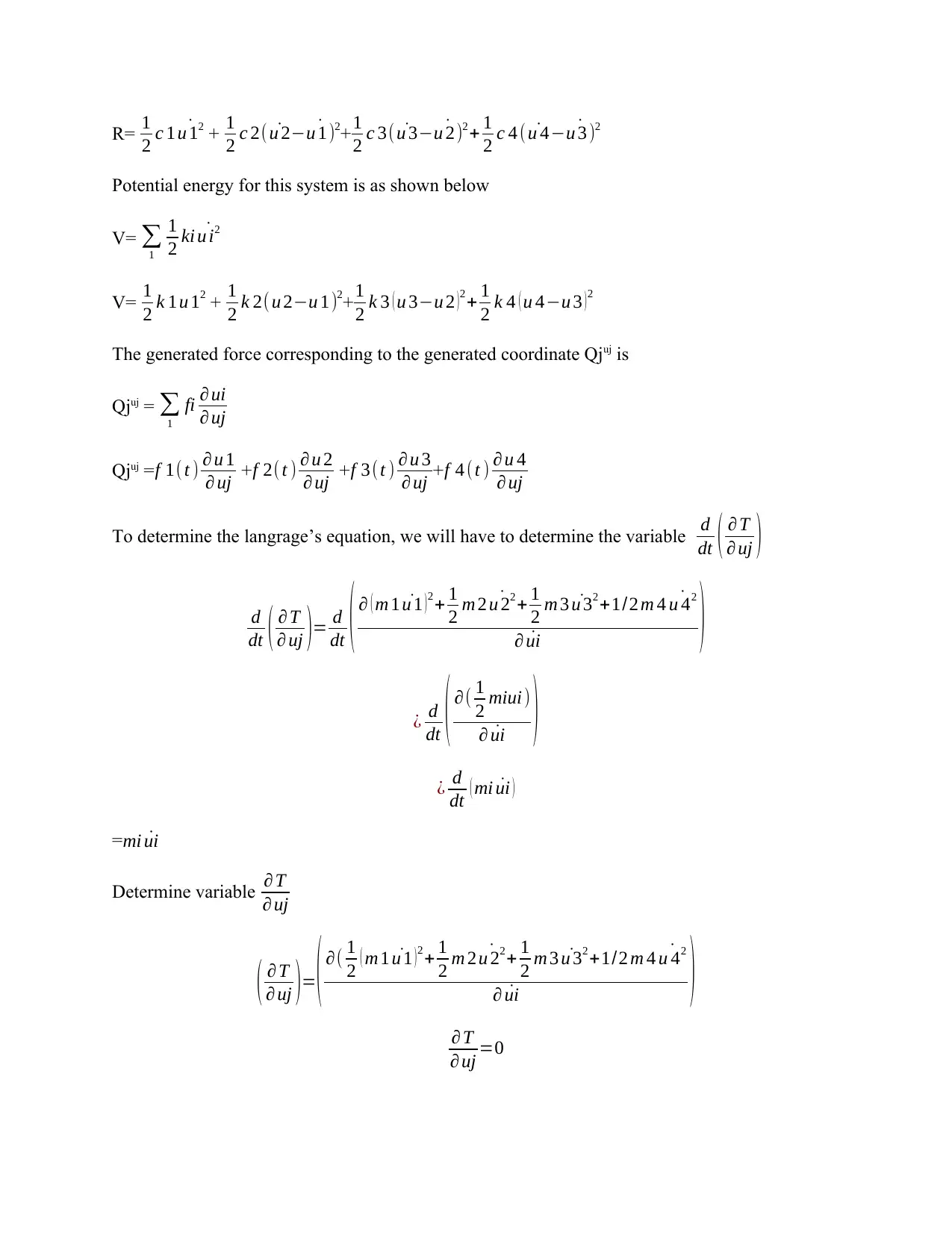
R= 1
2 c 1 ˙u 12 + 1
2 c 2( ˙u 2− ˙u 1)2+1
2 c 3( ˙u 3− ˙u 2)2+ 1
2 c 4 ( ˙u 4− ˙u 3 )2
Potential energy for this system is as shown below
V= ∑
1
1
2 ki ˙u i2
V= 1
2 k 1u 12 + 1
2 k 2(u 2−u 1)2+1
2 k 3 ( u 3−u 2 ) 2+ 1
2 k 4 ( u 4−u 3 ) 2
The generated force corresponding to the generated coordinate Qjuj is
Qjuj = ∑
1
fi ∂ ui
∂ uj
Qjuj =f 1( t ) ∂ u 1
∂ uj +f 2( t ) ∂ u 2
∂ uj +f 3( t ) ∂ u 3
∂ uj +f 4 ( t ) ∂ u 4
∂ uj
To determine the langrage’s equation, we will have to determine the variable d
dt ( ∂ T
∂ uj )
d
dt ( ∂ T
∂ uj )= d
dt ( ∂ ( m 1 ˙u 1 )2+ 1
2 m 2 ˙u 22+ 1
2 m 3 ˙u 32+1/2 m 4 ˙u 42
∂ ˙ui )
¿ d
dt ( ∂( 1
2 miui )
∂ ˙ui )
¿ d
dt ( mi ˙ui )
=mi ˙ui
Determine variable ∂ T
∂ uj
( ∂ T
∂ uj )=( ∂( 1
2 ( m 1 ˙u 1 )2+ 1
2 m 2 ˙u 22+ 1
2 m 3 ˙u 32+1/2 m 4 ˙u 42
∂ ˙ui )
∂ T
∂ uj =0
2 c 1 ˙u 12 + 1
2 c 2( ˙u 2− ˙u 1)2+1
2 c 3( ˙u 3− ˙u 2)2+ 1
2 c 4 ( ˙u 4− ˙u 3 )2
Potential energy for this system is as shown below
V= ∑
1
1
2 ki ˙u i2
V= 1
2 k 1u 12 + 1
2 k 2(u 2−u 1)2+1
2 k 3 ( u 3−u 2 ) 2+ 1
2 k 4 ( u 4−u 3 ) 2
The generated force corresponding to the generated coordinate Qjuj is
Qjuj = ∑
1
fi ∂ ui
∂ uj
Qjuj =f 1( t ) ∂ u 1
∂ uj +f 2( t ) ∂ u 2
∂ uj +f 3( t ) ∂ u 3
∂ uj +f 4 ( t ) ∂ u 4
∂ uj
To determine the langrage’s equation, we will have to determine the variable d
dt ( ∂ T
∂ uj )
d
dt ( ∂ T
∂ uj )= d
dt ( ∂ ( m 1 ˙u 1 )2+ 1
2 m 2 ˙u 22+ 1
2 m 3 ˙u 32+1/2 m 4 ˙u 42
∂ ˙ui )
¿ d
dt ( ∂( 1
2 miui )
∂ ˙ui )
¿ d
dt ( mi ˙ui )
=mi ˙ui
Determine variable ∂ T
∂ uj
( ∂ T
∂ uj )=( ∂( 1
2 ( m 1 ˙u 1 )2+ 1
2 m 2 ˙u 22+ 1
2 m 3 ˙u 32+1/2 m 4 ˙u 42
∂ ˙ui )
∂ T
∂ uj =0
Paraphrase This Document
Need a fresh take? Get an instant paraphrase of this document with our AI Paraphraser
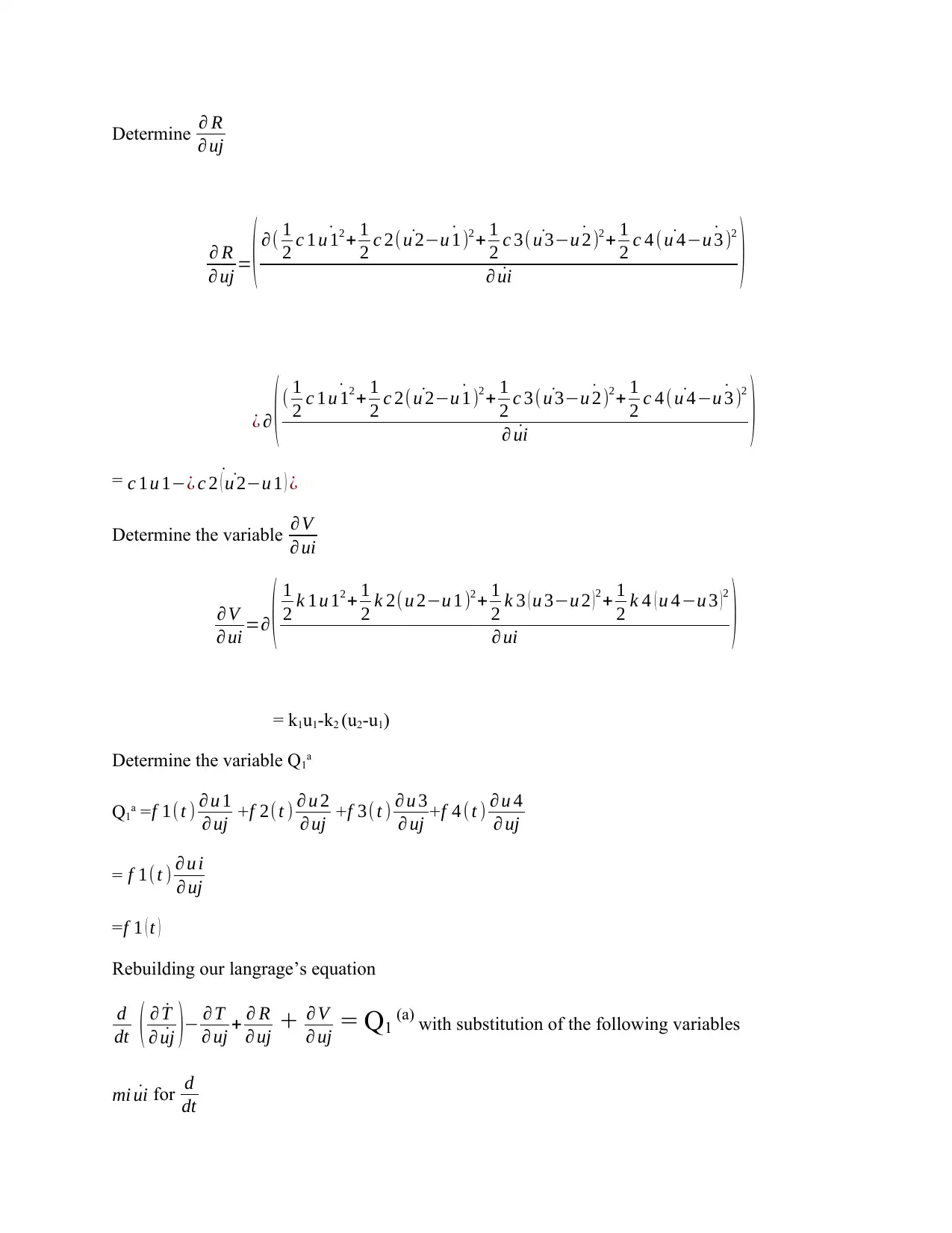
Determine ∂ R
∂ uj
∂ R
∂ uj =( ∂( 1
2 c 1 ˙u 12+ 1
2 c 2( ˙u 2− ˙u 1)2+ 1
2 c 3( ˙u 3− ˙u 2)2+ 1
2 c 4 ( ˙u 4− ˙u 3 )2
∂ ˙ui )
¿ ∂ ( ( 1
2 c 1 ˙u 12+ 1
2 c 2( ˙u 2− ˙u 1)2+ 1
2 c 3( ˙u 3− ˙u 2)2+ 1
2 c 4 ( ˙u 4− ˙u 3 )2
∂ ˙ui )
= c 1 ˙u 1−¿ c 2 ( ˙u 2−u 1 ) ¿
Determine the variable ∂ V
∂ ui
∂ V
∂ ui =∂ ( 1
2 k 1 u 12+ 1
2 k 2( u 2−u 1)2+ 1
2 k 3 ( u 3−u 2 ) 2+ 1
2 k 4 ( u 4−u 3 ) 2
∂ ui )
= k1u1-k2 (u2-u1)
Determine the variable Q1a
Q1a =f 1( t ) ∂ u 1
∂ uj +f 2( t ) ∂ u 2
∂ uj +f 3( t ) ∂ u 3
∂ uj +f 4 ( t ) ∂ u 4
∂ uj
= f 1( t ) ∂ u i
∂ uj
=f 1 ( t )
Rebuilding our langrage’s equation
d
dt ( ∂ ˙T
∂ ˙uj )− ∂ T
∂ uj + ∂ R
∂ uj + ∂ V
∂ uj = Q1 (a) with substitution of the following variables
mi ˙ui for d
dt
∂ uj
∂ R
∂ uj =( ∂( 1
2 c 1 ˙u 12+ 1
2 c 2( ˙u 2− ˙u 1)2+ 1
2 c 3( ˙u 3− ˙u 2)2+ 1
2 c 4 ( ˙u 4− ˙u 3 )2
∂ ˙ui )
¿ ∂ ( ( 1
2 c 1 ˙u 12+ 1
2 c 2( ˙u 2− ˙u 1)2+ 1
2 c 3( ˙u 3− ˙u 2)2+ 1
2 c 4 ( ˙u 4− ˙u 3 )2
∂ ˙ui )
= c 1 ˙u 1−¿ c 2 ( ˙u 2−u 1 ) ¿
Determine the variable ∂ V
∂ ui
∂ V
∂ ui =∂ ( 1
2 k 1 u 12+ 1
2 k 2( u 2−u 1)2+ 1
2 k 3 ( u 3−u 2 ) 2+ 1
2 k 4 ( u 4−u 3 ) 2
∂ ui )
= k1u1-k2 (u2-u1)
Determine the variable Q1a
Q1a =f 1( t ) ∂ u 1
∂ uj +f 2( t ) ∂ u 2
∂ uj +f 3( t ) ∂ u 3
∂ uj +f 4 ( t ) ∂ u 4
∂ uj
= f 1( t ) ∂ u i
∂ uj
=f 1 ( t )
Rebuilding our langrage’s equation
d
dt ( ∂ ˙T
∂ ˙uj )− ∂ T
∂ uj + ∂ R
∂ uj + ∂ V
∂ uj = Q1 (a) with substitution of the following variables
mi ˙ui for d
dt
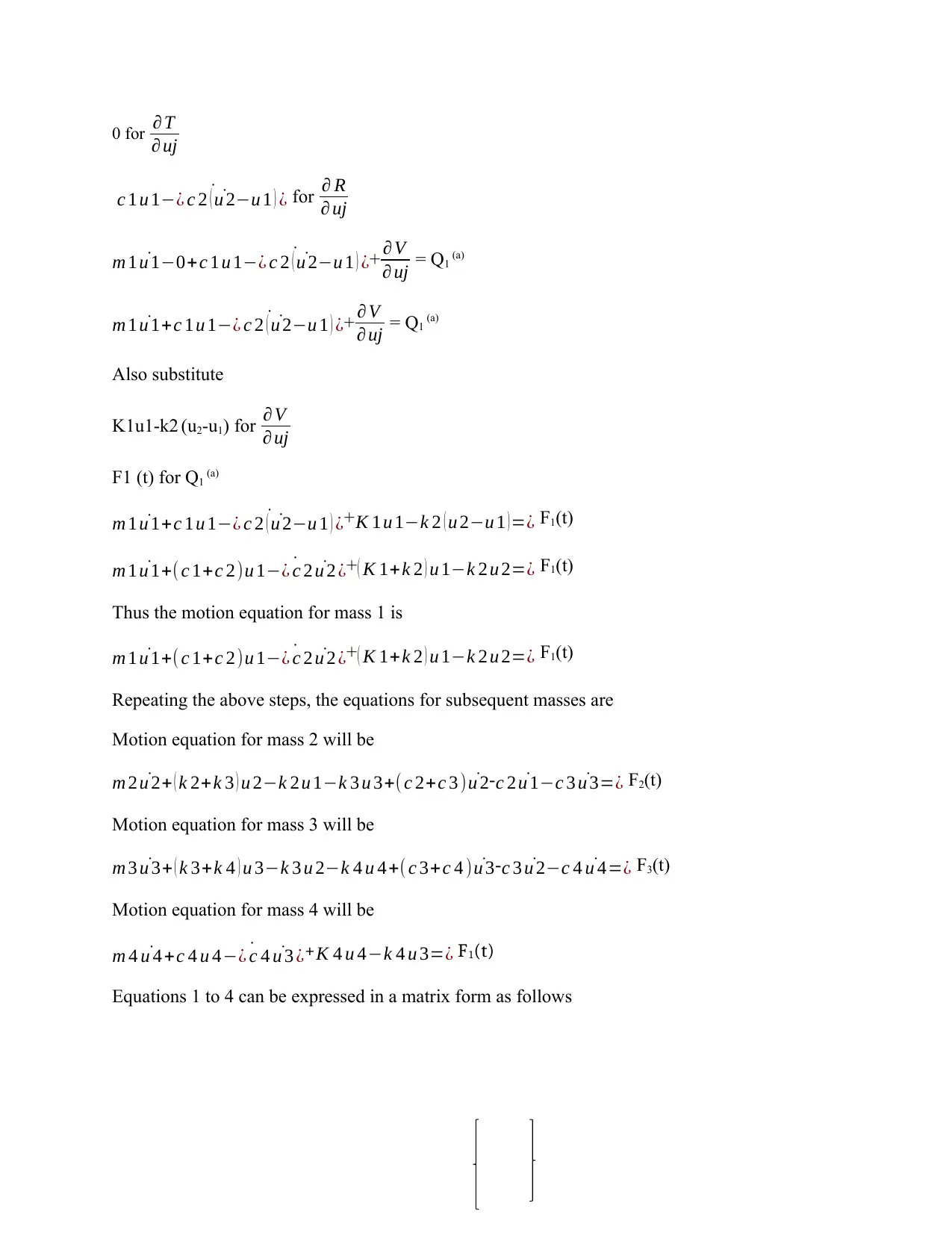
0 for ∂ T
∂ uj
c 1 ˙u 1−¿ c 2 ( ˙u 2−u 1 ) ¿ for ∂ R
∂ uj
m 1 ˙u 1−0+c 1 ˙u 1−¿ c 2 ( ˙u 2−u 1 ) ¿+ ∂ V
∂ uj = Q1 (a)
m 1 ˙u 1+c 1 ˙u 1−¿ c 2 ( ˙u 2−u 1 ) ¿+ ∂ V
∂ uj = Q1 (a)
Also substitute
K1u1-k2 (u2-u1) for ∂ V
∂ uj
F1 (t) for Q1 (a)
m 1 ˙u 1+c 1 ˙u 1−¿ c 2 ( ˙u 2−u 1 ) ¿+K 1 u 1−k 2 ( u 2−u 1 ) =¿ F1(t)
m 1 ˙u 1+( c 1+c 2) ˙u 1−¿ c 2 ˙u 2 ¿+( K 1+k 2 ) u 1−k 2 u 2=¿ F1(t)
Thus the motion equation for mass 1 is
m 1 ˙u 1+( c 1+c 2) ˙u 1−¿ c 2 ˙u 2 ¿+( K 1+k 2 ) u 1−k 2 u 2=¿ F1(t)
Repeating the above steps, the equations for subsequent masses are
Motion equation for mass 2 will be
m 2 ˙u 2+ ( k 2+k 3 ) u 2−k 2 u 1−k 3 u 3+( c 2+c 3 ) ˙u 2-c 2 ˙u 1−c 3 ˙u 3=¿ F2(t)
Motion equation for mass 3 will be
m 3 ˙u 3+ ( k 3+k 4 ) u 3−k 3 u 2−k 4 u 4+( c 3+c 4 ) ˙u 3-c 3 ˙u 2−c 4 ˙u 4=¿ F3(t)
Motion equation for mass 4 will be
m 4 ˙u 4+c 4 ˙u 4−¿ c 4 ˙u 3 ¿+K 4 u 4−k 4 u 3=¿ F1(t)
Equations 1 to 4 can be expressed in a matrix form as follows
∂ uj
c 1 ˙u 1−¿ c 2 ( ˙u 2−u 1 ) ¿ for ∂ R
∂ uj
m 1 ˙u 1−0+c 1 ˙u 1−¿ c 2 ( ˙u 2−u 1 ) ¿+ ∂ V
∂ uj = Q1 (a)
m 1 ˙u 1+c 1 ˙u 1−¿ c 2 ( ˙u 2−u 1 ) ¿+ ∂ V
∂ uj = Q1 (a)
Also substitute
K1u1-k2 (u2-u1) for ∂ V
∂ uj
F1 (t) for Q1 (a)
m 1 ˙u 1+c 1 ˙u 1−¿ c 2 ( ˙u 2−u 1 ) ¿+K 1 u 1−k 2 ( u 2−u 1 ) =¿ F1(t)
m 1 ˙u 1+( c 1+c 2) ˙u 1−¿ c 2 ˙u 2 ¿+( K 1+k 2 ) u 1−k 2 u 2=¿ F1(t)
Thus the motion equation for mass 1 is
m 1 ˙u 1+( c 1+c 2) ˙u 1−¿ c 2 ˙u 2 ¿+( K 1+k 2 ) u 1−k 2 u 2=¿ F1(t)
Repeating the above steps, the equations for subsequent masses are
Motion equation for mass 2 will be
m 2 ˙u 2+ ( k 2+k 3 ) u 2−k 2 u 1−k 3 u 3+( c 2+c 3 ) ˙u 2-c 2 ˙u 1−c 3 ˙u 3=¿ F2(t)
Motion equation for mass 3 will be
m 3 ˙u 3+ ( k 3+k 4 ) u 3−k 3 u 2−k 4 u 4+( c 3+c 4 ) ˙u 3-c 3 ˙u 2−c 4 ˙u 4=¿ F3(t)
Motion equation for mass 4 will be
m 4 ˙u 4+c 4 ˙u 4−¿ c 4 ˙u 3 ¿+K 4 u 4−k 4 u 3=¿ F1(t)
Equations 1 to 4 can be expressed in a matrix form as follows
⊘ This is a preview!⊘
Do you want full access?
Subscribe today to unlock all pages.

Trusted by 1+ million students worldwide
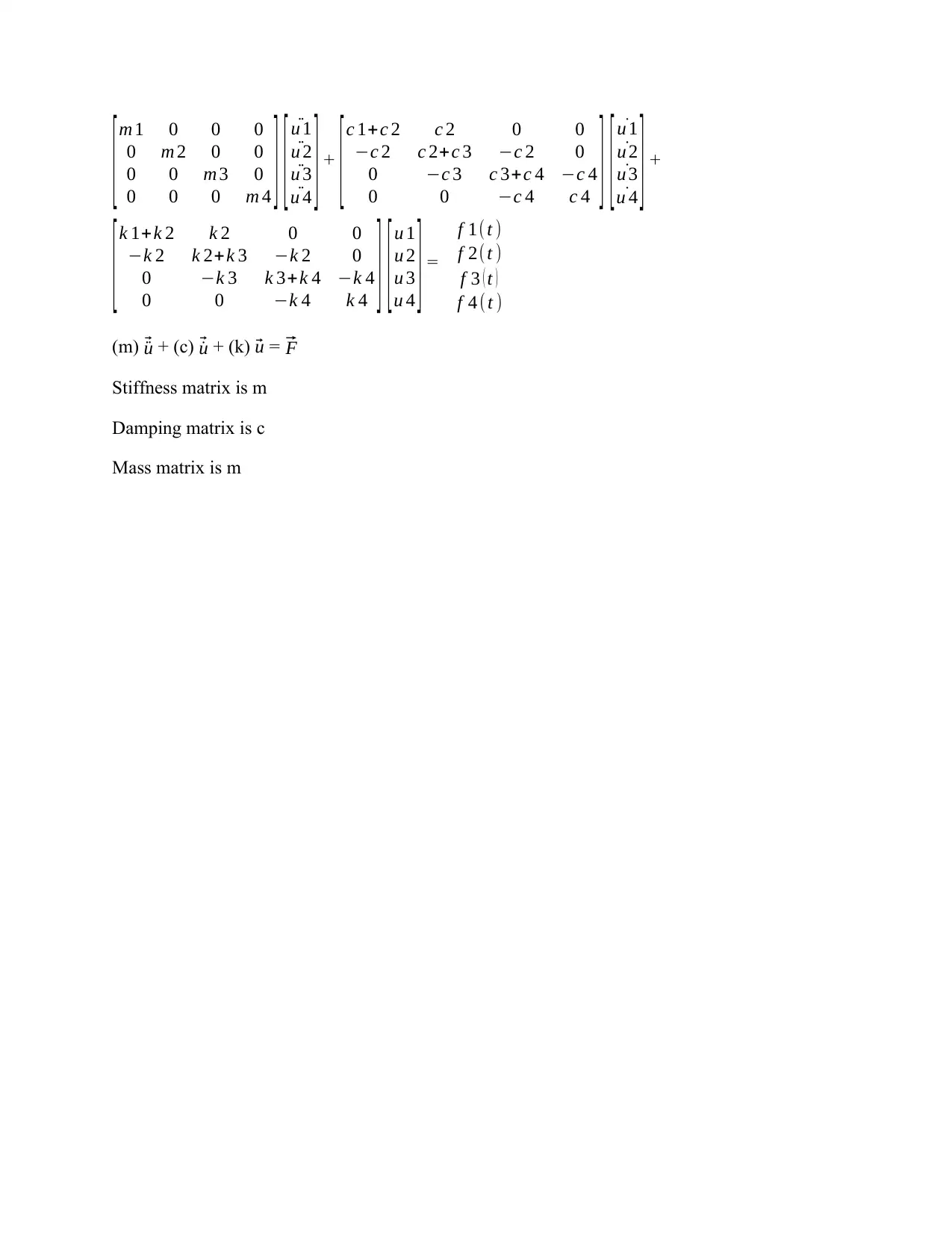
[m 1 0 0 0
0 m 2 0 0
0 0 m 3 0
0 0 0 m 4 ] [ ¨u 1
¨u 2
¨u 3
¨u 4 ] +
[ c 1+c 2 c 2 0 0
−c 2 c 2+c 3 −c 2 0
0 −c 3 c 3+c 4 −c 4
0 0 −c 4 c 4 ] [ ˙u 1
˙u 2
˙u 3
˙u 4 ] +
[k 1+k 2 k 2 0 0
−k 2 k 2+k 3 −k 2 0
0 −k 3 k 3+k 4 −k 4
0 0 −k 4 k 4 ] [ u 1
u 2
u 3
u 4 ] =
f 1( t )
f 2( t )
f 3 ( t )
f 4 ( t )
(m) ⃗ ¨u + (c) ⃗ ˙u + (k) ⃗ u = ⃗ F
Stiffness matrix is m
Damping matrix is c
Mass matrix is m
0 m 2 0 0
0 0 m 3 0
0 0 0 m 4 ] [ ¨u 1
¨u 2
¨u 3
¨u 4 ] +
[ c 1+c 2 c 2 0 0
−c 2 c 2+c 3 −c 2 0
0 −c 3 c 3+c 4 −c 4
0 0 −c 4 c 4 ] [ ˙u 1
˙u 2
˙u 3
˙u 4 ] +
[k 1+k 2 k 2 0 0
−k 2 k 2+k 3 −k 2 0
0 −k 3 k 3+k 4 −k 4
0 0 −k 4 k 4 ] [ u 1
u 2
u 3
u 4 ] =
f 1( t )
f 2( t )
f 3 ( t )
f 4 ( t )
(m) ⃗ ¨u + (c) ⃗ ˙u + (k) ⃗ u = ⃗ F
Stiffness matrix is m
Damping matrix is c
Mass matrix is m
1 out of 10
Your All-in-One AI-Powered Toolkit for Academic Success.
+13062052269
info@desklib.com
Available 24*7 on WhatsApp / Email
![[object Object]](/_next/static/media/star-bottom.7253800d.svg)
Unlock your academic potential
Copyright © 2020–2025 A2Z Services. All Rights Reserved. Developed and managed by ZUCOL.
